Introduction to Senecio Rowleyanus
Welcome to a verdant corner of the home where the charming Senecio Rowleyanus, also affectionately known as String of Pearls or String of Beads, thrives with enigmatic grace. Imagine a cascade of green pearls spilling over the edge of a hanging pot, each bead perfectly round and delicate, yet robust in its simplicity. This much-loved succulent has won the hearts of plant enthusiasts everywhere, not just for its unique aesthetics but also for the touch of whimsy it brings to any indoor space.
But why is the String of Pearls so adored among a sea of houseplants? Perhaps it’s the ease with which it grows, trailing along bookshelves and windowsills, creating a living tapestry that transforms the mundane into the magical. Or maybe it’s the plant’s resilience, its drought-loving nature making it a perfect companion for those who admire beauty without the high maintenance. The String of Pearls is like that friend who lights up the room, asks for little, and yet gives so much in return.
Embedded in each bead is the secret to its success—a clever adaptation for storing water, allowing it to survive and flourish where thirstier plants would falter. It’s no wonder that it’s become a symbol for sustainability in the realm of indoor flora. Indeed, succulent care guides sing its praises, highlighting its knack for enduring dry climates while still bestowing our homes with green opulence.
To truly appreciate the beauty of the String of Pearls, you just need to watch it in action. Behold a hands-on demonstration of its care—simple, straightforward, and utterly enthralling:
${‘‘}
For those yearning to delve deeper into the lush world of succulents, a treasure trove of knowledge awaits in our comprehensive guide on succulent care. It’s a realm where Green Thumbs and Novices alike can find verdant bliss among these unassuming pearls, each gently cradling the secret to thriving in a world that begs for a hint of green. As the String of Pearls keeps gaining popularity, it reaffirms our connection with nature, a green thread weaving through the fabric of our domestic lives, reminding us of the simple joys that come with nurturing a slice of Mother Earth.
Introduction to Senecio Rowleyanus
Welcome to the enchanting realm of Senecio Rowleyanus, where each strand is a celebration of nature’s playful geometry. Commonly known as the String of Pearls or String of Beads, this beloved houseplant is not just a feast for the eyes; it’s a storyteller. Its spherical leaves, resembling a string of verdant pearls, whisper tales of adaptability and beauty, making them a staple in the plant lover’s collection.
Imagine walking into a room where a curtain of these green pearls gracefully cascades from hanging pots, akin to a beaded doorway to an evergreen world. It’s this mesmerizing charm that captures hearts, turning a novice gardener into an avid collector. The String of Pearls isn’t just any plant; it’s a living sculpture that exemplifies ease and elegance, thriving on benign neglect and minimal care.
${‘‘}
A resilient survivor in the dry deserts, the String of Pearls has adapted to store water within its spherical foliage, a perfect example of form meeting function. This trait makes it an excellent choice for those seeking a touch of greenery without the demand for constant attention. As a plant that thrives with infrequent watering and moderate light, it found its spotlight in modern living spaces where other plants might not flourish.
In its trail of pearls, one sees a reminder of the resilience and simplicity of nature. Fans of this unique plant will find excellent care insights on our succulent care guide. And for those eager to learn more about creating their own personal green oasis, we provide a fascinating exploration into the world of succulents. Each String of Pearls tells its own story; are you ready to listen?
Botanical Profile and Origins
Deep dive into the world of Senecio Rowleyanus, colloquially known as the String of Pearls, and you will unveil fascinating botanical characteristics. Imagine rolling a handful of vibrant green pearls between your fingers; that’s the elegance and whimsy this succulent exudes. The leaves of this radiant plant are perfectly spherical, resembling a string of beads artistically draped over the edges of pots and shelves. Each bead, a storage unit for water, is an evolutionary masterpiece, a testament to the plant’s ability to thrive in arid environments.
Native to the arid landscapes of Southwest Africa, Senecio Rowleyanus has adapted to life where rainfall is as sporadic as a desert mirage. Its origins in such a challenging habitat mean that choosing the right soil is paramount for growing a healthy, thriving plant. In its natural habitat, it weaves through rocky crevices and makes its home in the shade of taller vegetation, a true jewel of resilience.
The grace of this succulent doesn’t end with its picturesque foliage; it is also known for its enchanting bloom. Given the right conditions, the String of Pearls can produce delicate, cinnamon-scented flowers that add a sweet surprise to its already captivating presence. As an added bonus, these blooms are a reminder that even the driest deserts can give rise to incredible beauty.
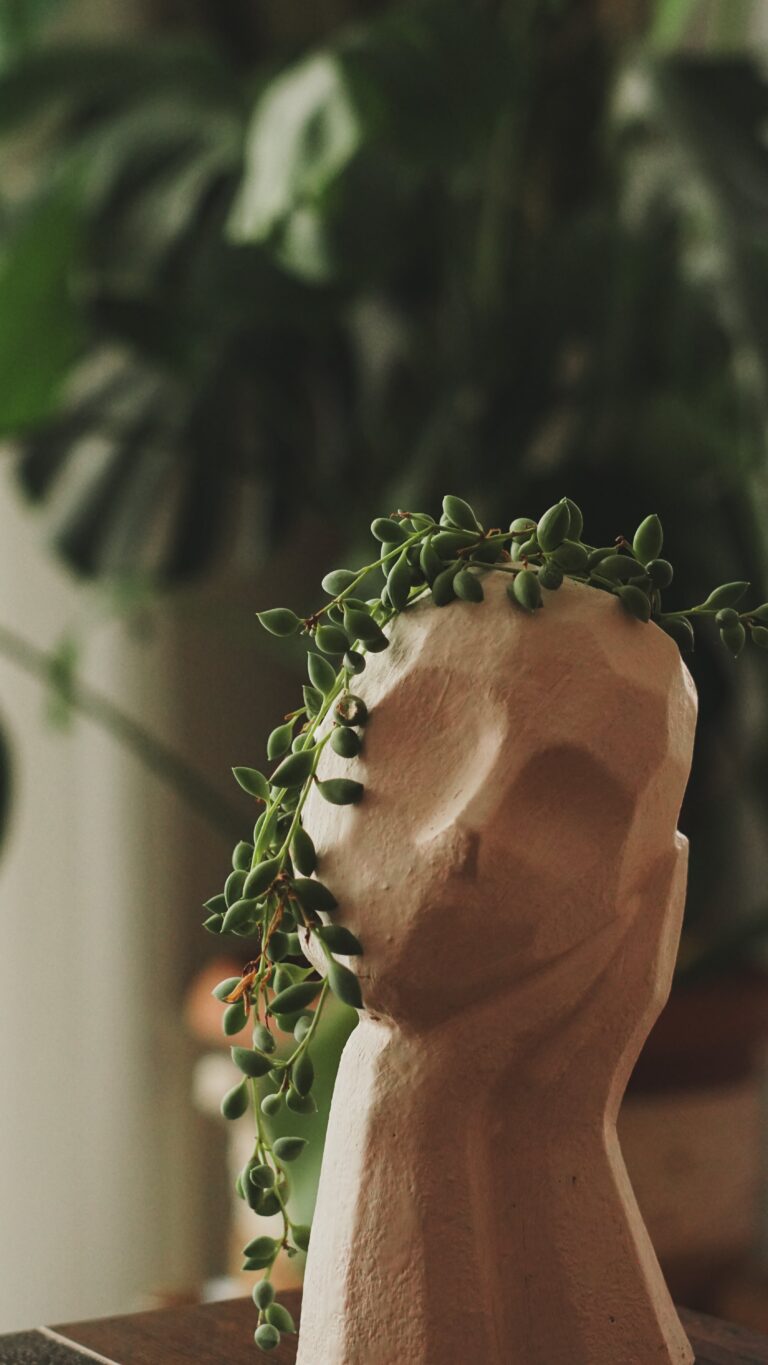
While Senecio Rowleyanus is a staple in succulent collections worldwide, it’s not just the charming appearance that captivates. It’s a symbol of beauty born out of austerity, turning a survival strategy into a delightful display that excites plant enthusiasts and casual admirers alike. Harnessing the secret life of this succulent’s origins uncovers a tale of survival, adaptation, and enchantment that transcends the limits of botany. A true marvel fringed with hundreds of pea-sized stories waiting to be told, the String of Pearls remains a botanical wonder that intertwines the past with the present.
Visual Description and Plant Attributes
Senecio rowleyanus, or as it’s delightfully referred to, the String of Pearls, is a plant that instantly captivates with its distinctive cascading vines. It’s a sight to behold — a living cascade of pea-green spheres, each daintily dangling like a necklace crafted by Mother Nature herself. These spherical little gems are not merely ornamental; they’re actually succulent leaves, filled to the brim with water as a reservoir to see the plant through dry spells.
The beauty of the String of Pearls lies in its ease of integration into any living space. Picture it suspended in a macrame hanger by the window, the afternoon sun casting dapples of light through its translucent pearls, or imagine it trailing along a bookshelf, adding a refreshingly organic touch to your collection of literature and keepsakes. It’s a tactile plant, evoking an urge to gently run fingers along its strands, feeling the coolness of each plump leaf.
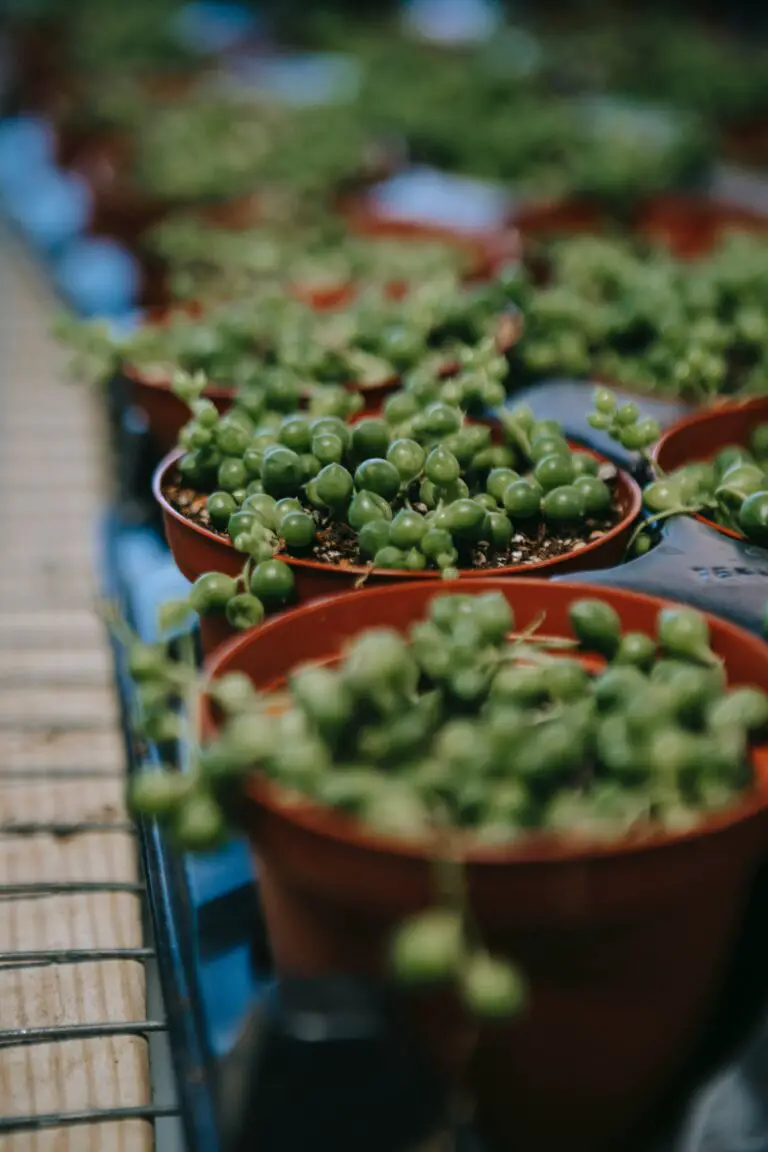
But Senecio rowleyanus is more than just its looks. This succulent is tailor-made for contemporary living, championing versatility and resilience. Its easy-care nature means it’s perfect for both seasoned green thumbs and those newer to plant parenthood, as discussed in our beginner’s guide to succulent gardening. Whether you’re an urban dweller with a compact apartment or someone who frequently travels, the String of Pearls won’t demand your constant attention. It thrives with a ‘less is more’ approach, asking for only occasional watering and a warm, bright spot to call home.
One of the most striking attributes of the Senecio rowleyanus is its ability to create an instant bond with onlookers. It’s a true conversation starter, a plant that’s both fascinating and inviting. As you host friends and family, it’s inevitable that someone will point and inquire about your hanging string of green baubles, opening the door to engaging discussions about the wonders of the plant world.
No wonder Senecio rowleyanus is celebrated among plant enthusiasts. For those seeking a touch of the extraordinary in their domestic jungle, this succulent is a must-have. With its appealing aesthetic and uncomplicated care, it teaches us the beauty of simplicity, how nature can astound us with the most basic of shapes, and how a single plant can influence the ambiance of an entire room.
Ideal Growing Conditions
Unlock the secret to nurturing your String of Pearls (Senecio Rowleyanus) into a luscious and elegant cascade of green beads! Imagine your home graced with these vibrant tendrils, each pearl-sized leaf a testament to your care. The formula for success lies in recreating the sparkle of its native habitat, so let’s explore the recipe for a thriving Senecio Rowleyanus.
Let There Be Light… But not Too Much!
Like the soft morning sun in its native Southwestern Africa, your String of Pearls desires bright, indirect light. A spot near a window with a sheer curtain would be the stage to showcase its beauty without the harsh midday glare. Allow your plant to bask in this gentle illumination for six to eight hours a day, and watch it flourish.
Warmth is a Warm Hug
Temperature is another crucial ingredient. Senecio Rowleyanus enjoys a warm embrace, thriving in temperatures between 70 and 80°F (21 – 27°C). In winter, this plant can tolerate a slight chill, down to 50°F (10°C), but remember, it prefers sweater weather over a winter coat!
Humidity: A Delicate Balance
Though not as finnicky as some tropicals, the String of Pearls plant appreciates a moderate level of humidity. A drafty windowsill or a bone-dry room near a heater may become this succulent’s nightmare. An average household humidity is generally sufficient, with a pebble tray or periodic misting ensuring its contentment.
For those eager to delve deeper into nurturing and understanding the String of Pearls, this video encapsulates the essence of caring for this delightful succulent, guiding you through the common pitfalls and triumphs of its cultivation.
To truly master the String of Pearls’ care, consider exploring this comprehensive guide. It’s an insightful read that will equip you with the know-how to ensure your trailing succulent remains as enchanting as the day you welcomed it into your home.
Patience and observance are your comrades on this green journey. Your String of Pearls will express its needs in subtle ways, and with this wisdom, you have set the stage for a botanical ballet of growth and vitality. A radiant spectacle of green pearls awaits!
Watering and Feeding: Best Practices
Imagine you’ve adopted a charming, trailing beauty—a String of Pearls (Senecio Rowleyanus)—that demands a delicate balance of nurturing. In this trail to cultivate a thriving cascade of green pearls, the key to success lies in mastering the art of watering and feeding your bejeweled companion. Let’s untangle the intricacies of this process.
First things first: Senecio Rowleyanus is no ordinary houseplant. Treat it like your typical fern, and soon you’ll find yourself holding a wake for your withered green gems. To avoid this distressing scene, think of your String of Pearls as a desert treasure that’s adapted to the ‘feast and famine’ regime. You’ll want to recreate this by allowing the soil to dry out completely between waterings—providing a generous drink but then giving it a chance to thirst for more.
Timing is everything; watering during the cool hours of the early morning or late afternoon encourages the soil to retain moisture for longer periods, minimizing the risk of root rot. Imagine it’s like preparing a slow-simmered stew, where the cooler temperatures allow flavors to meld without evaporating away.
As for feeding, consider the sumptuous spring and summer months as the seasons of growth, demanding more nutrients for your String of Pearls. A well-balanced, half-strength liquid fertilizer, subtly administered once a month, will suffice. Picture it as the mild but persistent encouragement you’d offer a budding artist.
And remember, less is often more. An overeager approach to fertilizing can lead to fertilizer burn—a telltale sign if you notice the tips of your pearls turning brown or yellow.
Visualize your Senecio Rowleyanus as a sought-after guest within your plant collection, one with refined tastes and specific wants. Mirror nature’s own pantry and you’ll be rewarded with a vibrant, pearl-draped spectacle.

By understanding and replicating the natural habits of Senecio Rowleyanus, your effort will culminate in an ornamental masterpiece that quietly boasts an aura of desert mystique. Isn’t it amazing how a bit of insight into watering and feeding can turn you into a green-thumbed guardian of a prosperous String of Pearls?
Potting and Soil Composition
Imagine you’re creating the perfect fluffy bed for your beloved Senecio Rowleyanus—a cushiony haven that not only feels like home but actually amplifies its growth. Well, think of potting and soil composition in much the same way. You need the right mix to cradle those delicate, pearl-like tendrils and ensure your String of Pearls plant thrives. Let’s dig into the dirt on what makes the ideal base for this succulent charmer!
Choosing the Perfect Soil Mix
The secret to a healthy Senecio Rowleyanus begins beneath the surface. This plant fancies a soil that mimics its natural, arid habitat. What you’re going for is a well-draining, airy mix. Combine cactus potting soil with perlite or pumice at a 2:1 ratio, and you’ve got a winning ticket. This concoction will prevent water-logging and provide plenty of space for roots to breathe and grow.
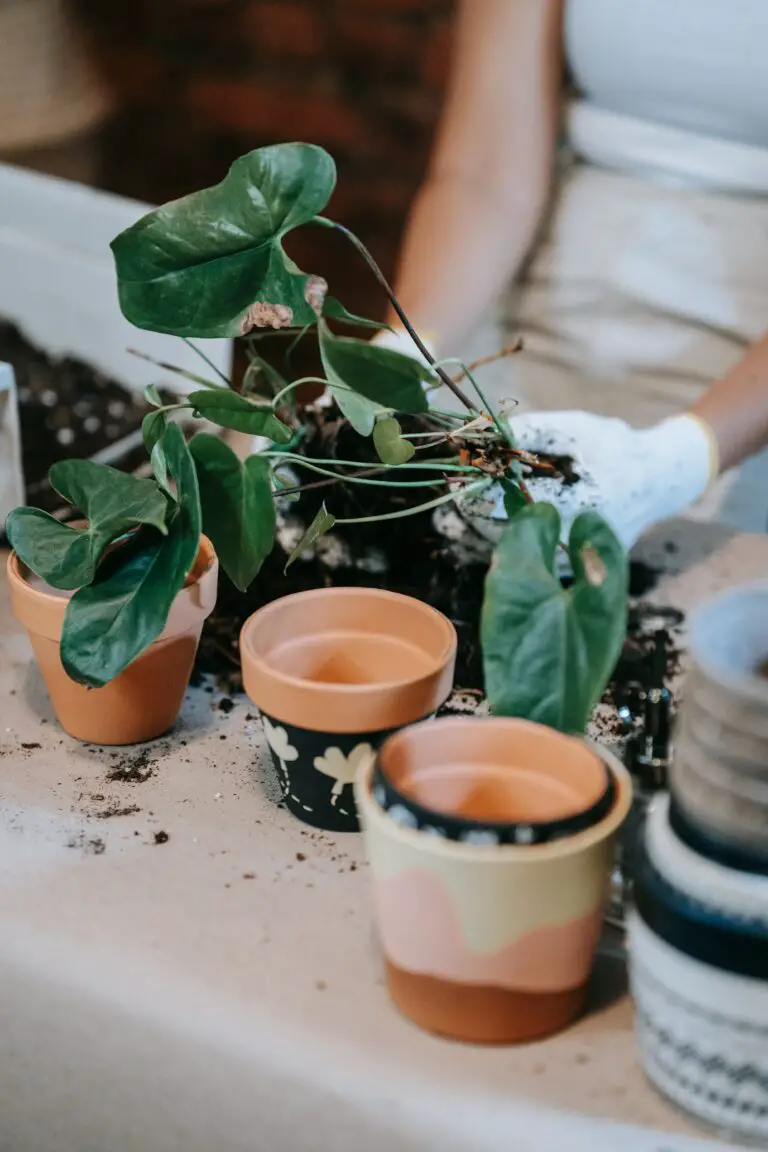
Pot Types and Drainage: Your Plant’s Safety Net
Now, about the trusty vessel for your precious succulent pearls. A terracotta or clay pot is your BFF here—they’re porous, allowing soil to dry out more consistently. Plus, they come with that au naturel look that goes so well with the Senecio Rowleyanus’ effortless style. Be sure the pot has ample drainage holes; this is your plant’s insurance policy against overwatering blues. If you’re feeling crafty, you can even DIY your own perfect pot with a drill and a bit of elbow grease!
Remember, an overwatered String of Pearls can quickly turn into a wilting string of woes. By giving it the right home from the get-go, you’re not just potting a plant; you’re setting the stage for a show-stopping display of trailing green beads that’ll have plant lovers green with envy. Keep it light, keep it breathable, and your Senecio Rowleyanus will reward you by cascading gracefully over the edges of its clay throne.
Pruning and Maintenance Tips
When it comes to nurturing your Senecio rowleyanus, or String of Pearls, the right pruning strategy can work wonders for its aesthetics and health. Imagine this: your String of Pearls has grown a bit unruly, resembling a wild tangle more than an elegant green cascade. Fear not! With a few snips here and there, you’ll transform your succulent into a verdant work of art. Let’s dive into how you can keep your green buddy thriving with the perfect trim!
Snip, Snip! Pruning for Fuller Growth
Envision yourself as a sculptor, and your shears as the chisel—every cut shapes your succulent’s future. To encourage fuller growth, focus on trimming lengthy, leggy stems just above a leaf node. This will inspire your plant to sprout new, lush trails from that point, eventually leading to a more voluminous appearance. And remember, those offcuts are not just waste; they’re potential new plants! Propagation pro tip: place those trimmings in soil and watch as they root and grow into new strings of succulent pearls.
Regular Maintenance: Keeping Your Plant Happy
Aside from the occasional haircut, your String of Pearls yearns for consistent TLC. Dust its delicate beads gently with a soft brush or cloth to keep them glistening. Be mindful of its thirst level—overwatering is a common faux pas among succulent enthusiasts. Allow the soil to dry between waterings to prevent root rot. And don’t forget the lighting; although it enjoys bright, indirect sunshine, too much direct light can lead to a sunburned string. Adjust its spot according to the seasons and your plant will reward you with a healthy, pearl-like sheen.
By incorporating these pruning and maintenance tips into your plant care routine, your Senecio rowleyanus will not only live but will flourish, adding an evergreen elegance to your living space. So, roll up your sleeves and give your String of Pearls the pampering it deserves!
Propagating Your Senecio Rowleyanus
If you’ve ever marveled at the delicate, bead-like foliage of the Senecio Rowleyanus, or String of Pearls, and wished you could replicate that beauty in multiple pots around your home, you’re in luck. Propagation is a simple and satisfying way to multiply your String of Pearls, and with these step-by-step instructions, you’ll be growing your garden in no time.
Step 1: Selecting Your Cuttings
Begin by finding a healthy section of your plant. You’ll want a portion that’s lush, green, and has plenty of ‘pearls’ on it. A segment about 4 to 6 inches long will be ideal for propagating. Gently snip it with a clean, sharp pair of scissors or a knife to avoid damaging the delicate stems.
Step 2: Preparing for Propagation
After you’ve taken your cuttings, lay them out on a piece of paper or a tray, and let them rest for a couple of days. This allows the cut end to callous over, which is crucial to prevent rot when you plant them. Meanwhile, prepare some well-draining soil in a shallow pot or tray—you want to replicate the arid conditions these succulents thrive in.
Step 3: Planting the Cuttings
Once your cuttings have formed a callous, it’s time to nestle them into the soil. Place the calloused end of the stem into the soil, ensuring that a few of the pearls are beneath the soil level. This is where the roots will sprout. Remember to space out the cuttings; giving them room to grow is important for developing a full, healthy plant.
Step 4: The Right Environment
String of Pearls loves indirect light and a warm environment, so find a cozy corner for your new planting that fits the bill. Avoid direct sunlight at first, as it can be a bit harsh on the fresh cuttings. Patience is key in this stage—keep the soil slightly moist, but be cautious not to overwater, as succulents are prone to rot in soggy conditions.
Step 5: Watch Them Grow
Keep an eye on your propagated cuttings and look out for new growth. In a few weeks, you’ll notice small roots or even new pearls forming. It’s a subtle nod from your Senecio Rowleyanus that it’s happy and healthy in its new home.
Imagine strings of lush green pearls cascading gracefully from their pots, all because you took the time to learn the art of propagation. If you ever doubted your green thumb, seeing your successful propagation efforts flourish will surely change your mind.
And here’s a visual tip for you. Just look at how well these succulent cuttings are being nurtured—your String of Pearls could look just as thriving!
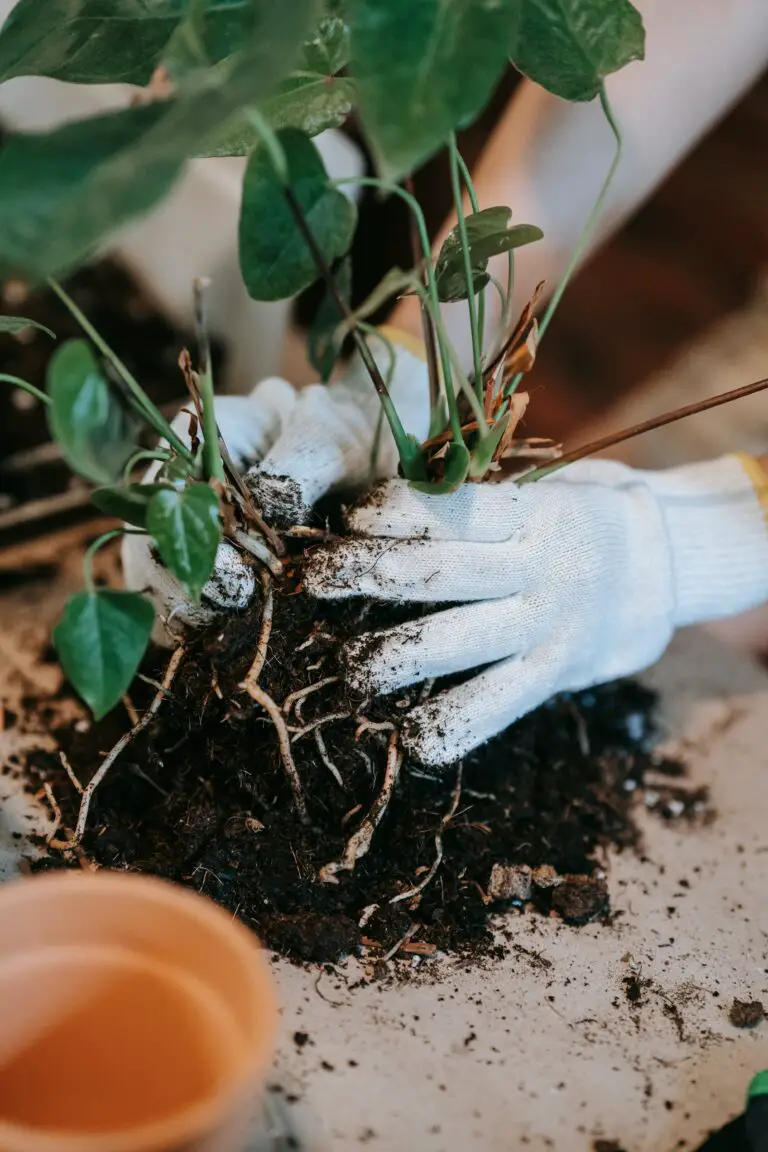
Remember, the journey of propagating your Senecio Rowleyanus is as fulfilling as the destination. Each new plant is a testament to the time and care you’ve invested, and a reminder of nature’s endless capacity for growth and renewal.
Common Pests and Problems
Whether you’re a seasoned green thumb or have just welcomed a new Senecio Rowleyanus (String of Pearls) to your plant family, there’s a dash of vigilance required to keep your beaded beauty pest-free and thriving. Just like a pearl necklace might attract admirers, your String of Pearls can draw in some uninvited guests. Here, we’ll string together some insights to keep your plant robust and resilient.
Unwelcome Critters
One of the more common invaders you might encounter is the mealybug—tiny, soft-bodied insects that adore hiding in the crevices between your plant’s pearls. They can be a nuisance, sapping the vitality from your plant and leaving a sticky residue called honeydew. Combat these pests by introducing their natural enemy, ladybugs, or dabbing them with a cotton swab soaked in rubbing alcohol for a more hands-on approach.
Aphids, too, can crash your pearl party. These pesky insects are sap-suckers, draining the life from your Senecio and potentially spreading disease. A strong stream of water or insecticidal soap can send these critters sailing away from your String of Pearls. For an example that hits close to home, just think of that one time you discovered a congregation of aphids and sent them off on a mini Niagara Falls adventure—isn’t that right?

Fungal Foes
Aside from insect interlopers, Senecio Rowleyanus can fall victim to fungal foes, such as root rot, which occurs when your botanical bauble sits in soggy soil. Keep the soil well-draining, and let it dry out between drinks to avoid this issue. Imagine the regret, like that of overwatering your first Rowleyanus—turning those firm pearls into mush. Learn from that splash of the past and guarantee your plant’s future firmness.
Powdery mildew is another uninvited fungus that can coat your precious pearls. It typically manifests as a white or gray powdery film on the leaves and stems, and it thrives in humid conditions with poor air circulation. Keep your String of Pearls in a well-ventilated spot and treat mildew with neem oil or a homemade baking soda solution to clear up this unsightly blemish.
In the end, keeping a watchful eye and being proactive with these tips can ensure that your Senecio Rowleyanus remains a lush, vigorous testament to your plant-care prowess. Tend to it as you would a treasured jewel, and it will surely reward you with its full, cascading splendor.
Design and Display in the Home
The enchanting Senecio Rowleyanus, lovingly dubbed the String of Pearls, lends a touch of whimsy and elegance to any room. Let’s unpack some imaginative ways to showcase this gem in your home or office, ensuring it becomes a conversational masterpiece. Whether you’re a seasoned green thumb or simply have a penchant for cheerful spaces, prepare to be inspired!
Statement Suspensions
Imagine walking into a room where delicate trails of pearls cascade from the ceiling, swaying gently with the breeze. Hanging your Senecio Rowleyanus in macramé plant hangers or on sleek minimalist shelves can create a spectacular floating garden. It’s a simple yet striking way to add vertical interest and make your ceiling part of the decor conversation.
Office Oasis
Transform your workspace into a sanctuary with this verdant vibe. A single String of Pearls on a high shelf, near your computer, or even luxuriously spilling out of a bookshelf can help soothe the stress of the daily grind. It’s not just visually uplifting but also a nod to biophilic design, which integrates nature into our habitats for greater well-being.
Lively Living Spaces
Liven up your living room with an eclectic display of Senecio Rowleyanus. Pair it with an assortment of other succulents on a coffee table, or let it stand alone as a living, breathing sculpture atop a trendy tripod stand. The unique pearl-like leaves add an organic texture that contrasts beautifully with modern decor.
Not only does this plant accentuate your style quotient, but it also thrives with a bit of neglect, making it perfect for the hustle and bustle of today’s lifestyles. So, gather those chic pots, get creative with your spaces, and let the serene beauty of the String of Pearls enliven your environment.
The understated charm of a well-placed Senecio Rowleyanus can’t be overstated. It blends so seamlessly with any interior design language, be it minimalist zen or colorfully bohemian. There’s simply no wrong way to display the natural elegance of the String of Pearls.
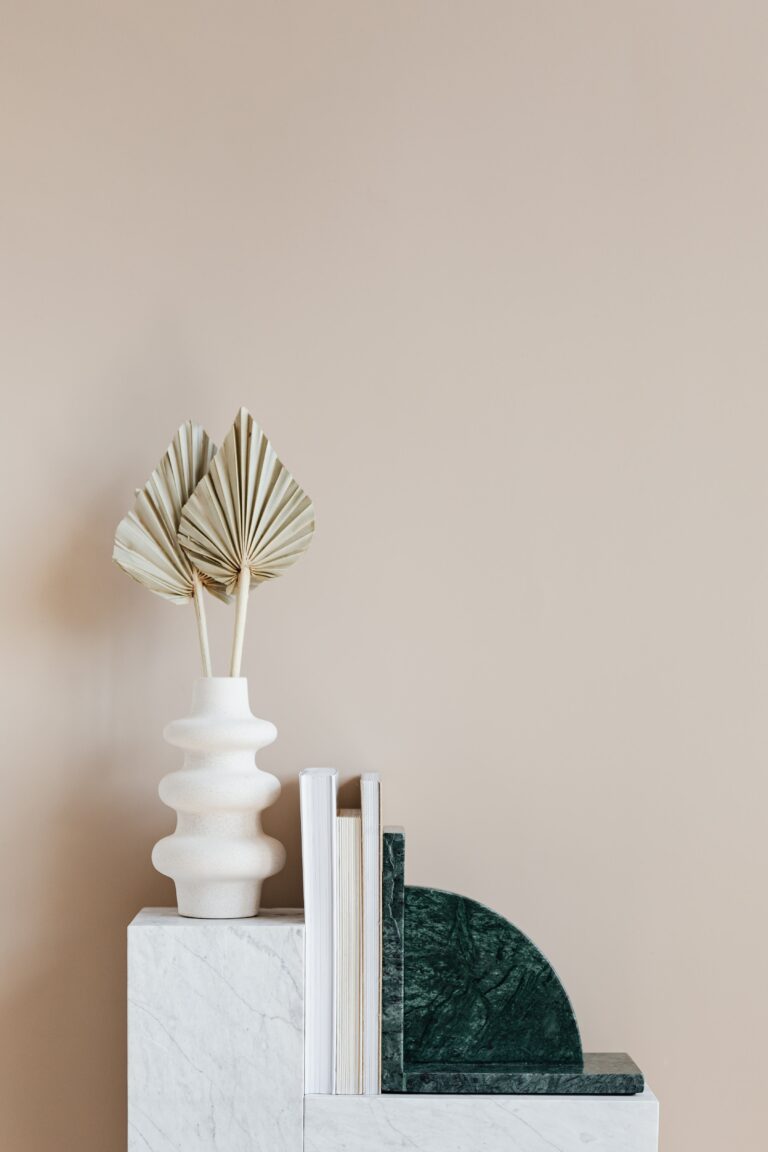
Environmental Impact and Sustainability
Introducing nature into our homes with eye-catching houseplants like Senecio rowleyanus, also known as the String of Pearls, isn’t just a trend, it’s a step towards a greener future. But have you ever wondered about the environmental footprint of your indoor jungle? Let’s unravel this botanical conundrum together.
Firstly, the String of Pearls originates from the arid regions of Southwest Africa. They are pros at storing water within their pearl-like leaves, making them champions of water conservation. By choosing these drought-tolerant succulents, you’re reducing the need for frequent watering, ensuring our precious water resources aren’t poured down the drain—literally.
Minimal Footprint, Maximum Impact
Here’s a refreshing thought: Senecio rowleyanus isn’t just pretty to look at; it’s a plant with purpose. These succulents are low maintenance, needing minimal resources to flourish. This means fewer fertilizers and pesticides, which, let’s face it, can be the not-so-green villains of the gardening world. In short, String of Pearls has a minimal ecological footprint but delivers a maximum aesthetic and environmental impact.
Beading Together a Sustainable Future
But the impact of these green beads goes beyond just water savings and reduced chemicals. Embracing plants like the String of Pearls can nurture an ecosystem right in your home. They’re part of a sustainable home gardening trend that champions responsible plant parenting. By choosing eco-savvy species, you’re making a statement: you care about the planet as much as you care about your leafy companions.
Imagine this: each String of Pearls plant is a natural air purifier, quietly sifting through the air, trapping pollutants, and gifting you with cleaner oxygen. Now, multiply that by every urban gardener’s plant collection, and you’ve got a grassroots movement towards better air quality, one dangling tendril at a time.
To get a glimpse of how effortless yet impactful eco-friendly gardening can be, let’s take a look at this video showcasing an innovative way to approach our green endeavors.
While Senecio rowleyanus may not seem like a game-changer at first glance, its place in our homes is a silent nod to the sustainable choices we can all make. These succulents prompt us to rethink our habits, leading by example with their own low-impact lifestyle. It’s not just about growing plants; it’s about growing a better future, one pearl at a time.
Frequently Asked Questions (FAQs)
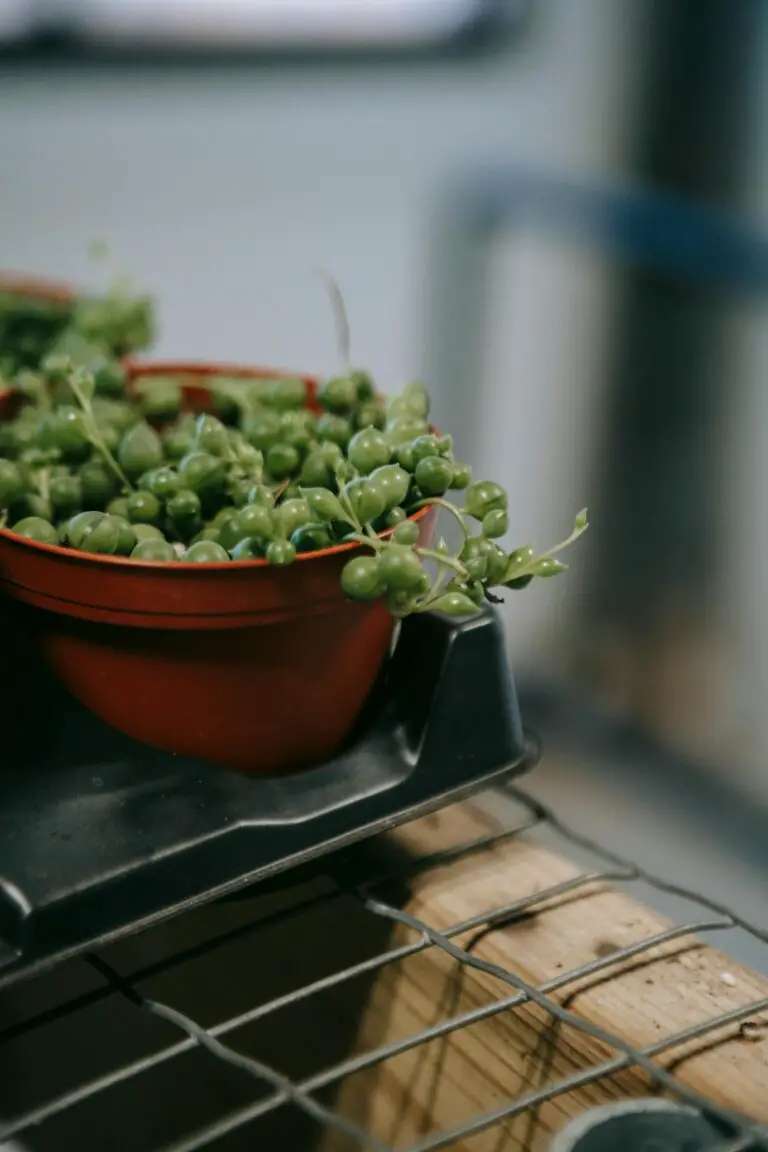
Charming, unique, and slightly whimsical, Senecio Rowleyanus – also known as String of Pearls – has captured the hearts of plant enthusiasts far and wide. But with its distinctive pearl-like leaves and trailing growth, you might find yourself tangled in a web of questions about its care. Fret not! Let’s untangle some of the most common inquiries together.
Caring for String of Pearls Through the Seasons
As the days stretch and shrink, so does the care regimen for our lovely beaded beauty. In the luminous summer months, when the sun is a generous patron to your green friends, the String of Pearils demands a watchful eye for watering – just enough to keep its soil damp, similar to the feeling of a wrung-out sponge. Imagine a summer storm, brief and refreshing. Come winter, when the sun plays coy, reduce the watering to a sparing affair, mimicking the gentle touch of a drizzle.
Is the String of Pearls Safe for Pets?
Our furry friends may be curious about the dangling tapestry of pearls. Caution, though, for the alluring tendrils of Senecio Rowleyanus are not as innocent as they seem. Ingesting this plant could invite unwanted health soirées for pets. It’s best to place the plant on a high shelf or in a macrame hanger, swaying safely out of paw’s reach, much like a mobile over a child’s crib.
Signs of a Flourishing Senecio Rowleyanus
A thriving String of Pearls is akin to a string of well-crafted pearls – full, glossy, and with a touch of the sea’s shine. Fresh green color, vigorous pearl growth, and beads that are plump with hydration speak of a plant that’s not just surviving, but prospering in your care. Conversely, a withering plant will have shriveled pearls, like grapes longing for the kiss of the sun, converted into raisins. When you spot pearls that shimmer with vitality, you’ll know you’re on the path of the green-thumbed virtuoso.
Remembering Watering Habits with a Tale
Let’s spin a yarn to help recall the ideal watering routine for your pearl-laden charge. Think of the String of Pearls as a treasure you’d find in a seafarer’s journey. In spring and summer, water as if your plant has just found its way through the Sirens’ call – sparingly, for it needs to conserve its resources. As the seasons turn to autumn and winter, consider it safely docked in harbor, requiring even less to sustain its need. Thus, with each passing season, let your watering can narrate the epic of your Senecio Rowleyanus.



